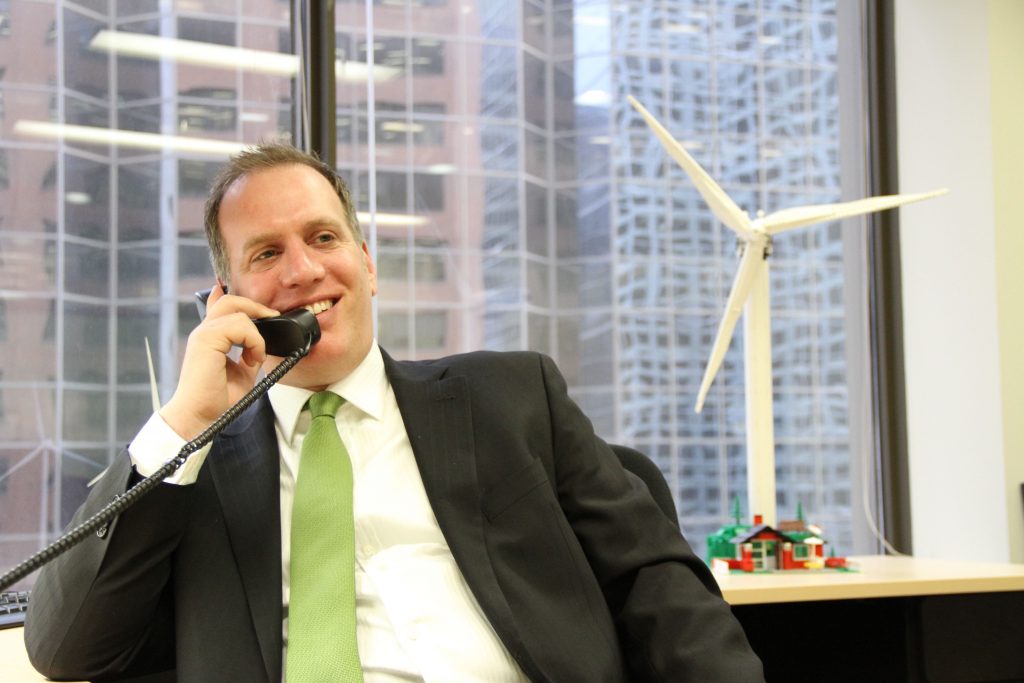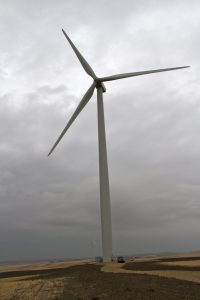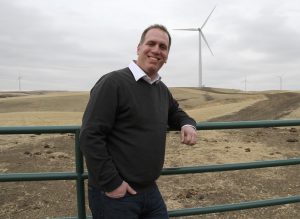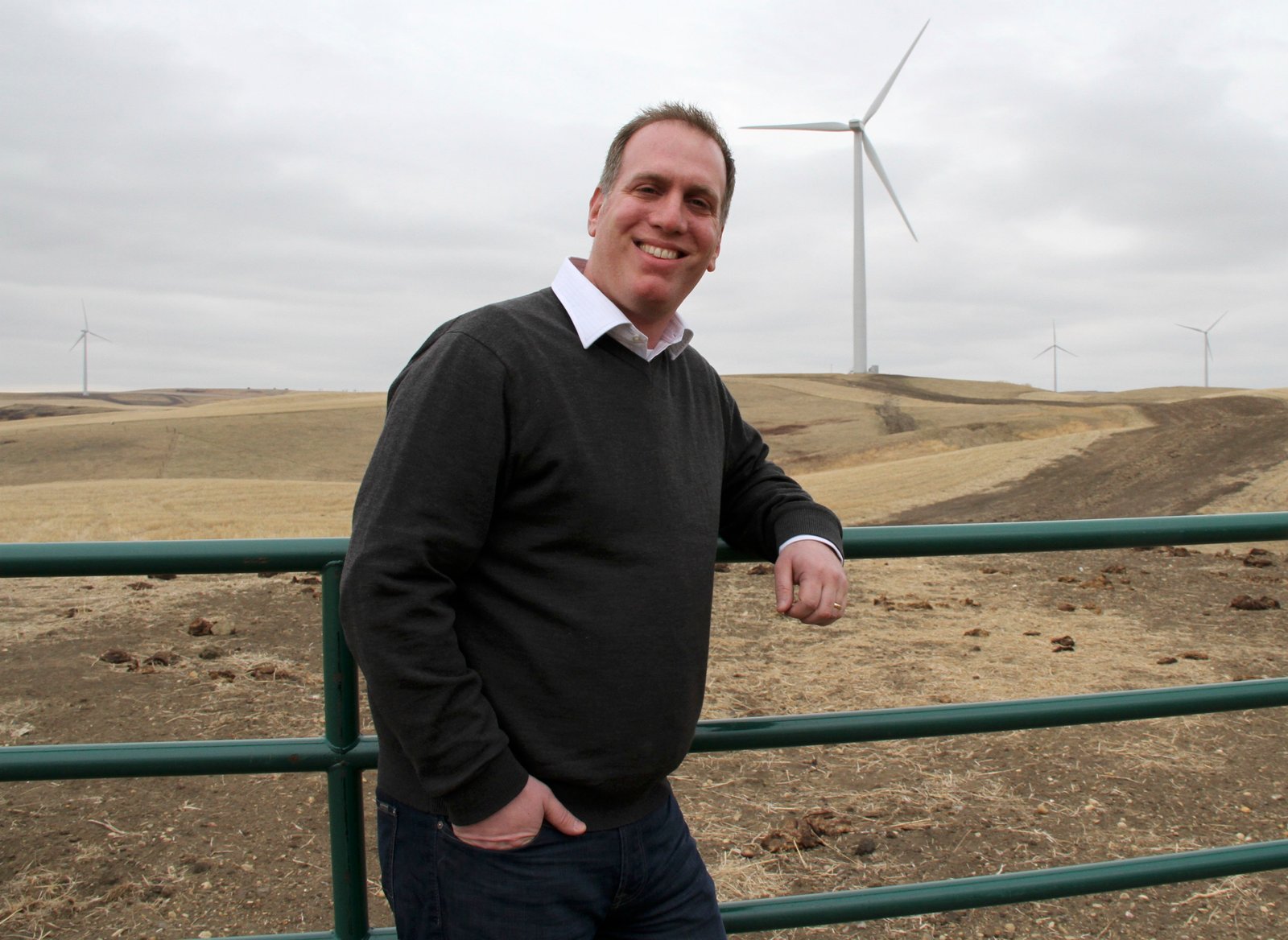By David Dodge and Duncan Kinney
The small, sleepy town of Halkirk, Alberta is home to 121 people. Its biggest claim to fame is being the birthplace of longtime NHLer Shane Doan. Well that and the yearly Halkirk Bullarama, where cowboys take their turn on some pretty rank bulls.
But it’s a different kind of cowboy that has shaken the town up. For the next two years the population of Halkirk will more than double as around 200 workers build the massive 150 megawatt Halkirk wind project.
That’s the kind of effect a wind energy cowboy can have on a town.
Dan Balaban is the president of Greengate Power and a wind energy entrepreneur. He has gone from no experience in renewable energy to cutting deals for the largest wind farms in Canada in five years.
He’s brash, bold and confident and he’s pulling off big projects in a province that doesn’t have any subsidies and has an electrical grid dominated by coal.
“This is the third business that I’ve started up so it’s not my first rodeo,” says Balaban.

Dan Balaban, the founder of Greengate Power with a to-scale Lego model of a Vestas wind turbine.
A dedicated entrepreneur Balaban got his start running a software company that helped oil and gas companies manage everything from inventory to greenhouse gas emissions. When he sold his company he knew the next thing he wanted to do was in the green space. That was when he started Greengate Power, a privately held wind developer.
You’d think going from the oil business to the wind business would be like trading easy money for a fruit stand in the Okanagan, but Balaban says wind is big business.
“The green industry is one of the best business opportunities of the next decade. In wind energy alone it’s been estimated there’s going to be over a trillion dollars invested in wind energy and related infrastructure over the next decade.”
You don’t get rich opening another neighborhood laundromat and Balaban wasn’t interested in developing just another wind farm. While many other wind companies were wrestling over limited space and transmission capacity in the windy Pincher Creek corridor of Alberta, Greengate headed up the highway in the opposite direction.

A wind turbine at the Wintering Hills wind farm owned by Suncor Energy.
“Instead of following the wind, like every body else does, we followed the transmission lines, because unless you can connect into the transmission grid you can’t bring your product to market as a wind energy project.”
“The second thing that we did is that we found the best market in the world in which we could sell the environmental benefits that are generated by our projects,” As Balaban explains “Wind energy projects produce two sources of revenue.” Wind farms produce electricity of course, but they also generate environmental benefits.
“We have done the first and only deal to sell our renewable energy credits to a California-based utility,” says Balaban. This is great for Greengate Power, but some wonder why Alberta, a province burdened with a bad rep for fossil fuel pollution isn’t investing in clean energy.
From zero to almost 1,500 megawatts
Greengate Power’s website says the company is working on 1,450 megawatts of wind energy projects on 165,000 acres of private land in Alberta. Alberta currently only has 891 megawatts of wind energy capacity. If these projects are built it would increase wind energy capacity in Alberta by more than 60 per cent.
Balaban and his company Greengate Power are project developers. In a province with very little support for renewable energy Greengate Power does the heavy lifting – weaving through unclear permitting processes, negotiating with landowners who must participate voluntarily and then they must drum up hundreds of millions of dollars to finance the projects. They are pioneers in the wild west of the wind energy business.
That’s what makes Greengate’s Halkirk project such a milestone. Greengate sold the shovel-ready Halkirk project to Edmonton-based utility Capital Power for $33 million dollars.
The 150 megawatt Halkirk wind project will consist of 83 giant Vestas V80 wind turbines. These 80 metre tall behemoths will generate enough electricity to power 50,000 homes in Alberta and reduce emissions enough to take 60,000 cars off the road.
The foundation pads for the Halkirk wind project are currently being poured and the massive turbine components are expected to arrive in July. The project is slated to be operational by the end of 2012. (watch for a photo essay this summer)
Halkirk will be the largest wind project in Alberta. Their next project, called Blackspring Ridge 1 is set for completion at the end of 2013 and at 300 megawatts promises to be the largest wind farm in Canada.
How the wind business is different

Dan Balaban, the founder and CEO of Greengate Power has almost 1500 megawatts of wind projects in the pipeline.
In the oil and gas industry landowners are obligated to deal with the companies who own the mineral rights under their land. Wind energy companies like Greengate are only able to access private land through careful negotiations and by keeping everybody happy. There is no legal imperative compelling farmers to work with them.
On a typical wind farm you often get a backlash from neighbors who don’t have wind farms on their property and don’t see any money coming their way. Greengate takes a slightly different approach. They negotiate agreements with all of the land owners in an area where they are proposing a project and they pay a little bit of rent to all of the owners and pay a little more to the owners who have turbines on their land.
“Sustainability is not just about the kind of energy you produce, it’s about the kinds of relationships you develop,” says Balaban.
Balaban says that creating a “truly equitable compensation model” helped Greengate acquire enough land for their upcoming 300-megawatt Blackpring Ridge project without a single outstanding public objection.
Ever wake up and wish you were in Ontario?
Balaban skirts the question of whether he would prefer to be in Ontario where a feed-in-tariff assures developers of a return on major renewable energy projects.
“I’m very proud to be an Albertan,” says Balaban. “Alberta has among the best wind resources in the world.” Balaban says the government and the people make it an easy place to do business. “Everyone is really pro-economic development.”
Balaban won’t complain, but you would think in a province that is so pro-economic development that a guy ready to develop a few billion dollars worth of wind projects would get more respect. Balaban believes Alberta could use a few more supportive policies that help remove barriers and encourage the development of new clean tech industries such as wind.
“And an appropriate policy framework in Alberta would result in an explosion of wind energy development across the province.”
Balaban is not kidding. Greengate’s projects add up to almost 1,500 megawatts and are worth more than $3 billion dollars.
What about wildlife impacts?
“All sources of energy are going to have impacts on wildlife, but the impacts that wind has on wildlife is very benign relative to other sources of energy,” says Balaban.
One study done by the New York State Energy Research and Development authority found wind to have the second lowest impact on wildlife of all the methods of generating electricity.
These days Balaban says wind developers must do environmental assessments, survey the wildlife pre-construction and monitor wildlife effects post-construction to ensure minimal wildlife impacts.
But more can be done than just clucking our tongues, there are proven ways to mitigate wildlife impacts. One TransAlta wind farm found its turbines were harming bats. After a few years of research they learned that they could reduce the impact by 60 per cent by halting the rotation of the blades in low winds during at the time of the year when bats are migrating. That research has since been used to help numerous wind installations.
Greengate power’s big ambitions
In some ways operating largely under the radar in Alberta has helped Greengate develop its business in places where people welcomed them. In Ontario renewable energy is big business, big politics and often controversial.
Consider the impact of one man – with just two of Greengate’s projects, Halkirk and Blackspring Ridge 1, Albertans will see their province’s wind capacity increase by 50 per cent. The capital investment required for these two projects – more than a billion dollars.

A cow in the field near the Summerview wind farm near Pincher Creek.
<p >Source: youtube.com via David on Pinterest

